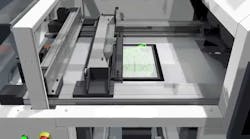Latest from Materials
Could Cold Plasma Change HPDC?
Waupaca Sees Efficiency Gains from New Law
Modeling Aluminum Oxidation
Quiz: Know the Metals!
OSHA Cites Schumann for Blast
Additive manufacturing technology supplier The ExOne Co. licensed a patent-pending technology for 3D printing aluminum-infiltrated boron carbide (B4C) collimators, and other components used in neutron imaging, from the U.S. Dept. of Energy’s Oak Ridge National Laboratory (ORNL). ORNL researchers used the ExOne M-Flex® binder-jet printing system used to produce 3D objects in metals like stainless steel, bronze, or tungsten, as well as to print objects in sand, ceramics, and composite materials.
ExOne also agreed to 3D print various B4C matrix components used in neutron scattering experiments at ORNL. And, it will offer the new B4C material as a lightweight material for 3D printing, one "that is lighter than bronze," it said.
The ORNL research team, led by David C. Anderson, group leader of Instrument Engineering, developed a process to 3D-print objects in B4C (boron carbide, a neutron-absorbing material), and then infiltrate the objects with aluminum. Infiltrating or infusing boron carbide with aluminum results in a metal-matrix composite (MMCs.)
Aluminum-infused B4C is strong but lightweight but also energy-absorbing in ways that are said to be “particularly useful in neutron scattering instruments”, i.e., an imaging process for capturing structural data at the atomic level of objects. The data is converted to images, comparable to X-ray or CT data, but even more revealing.
“It delivers results that X-rays can’t,” explained Dan Brunermer, an ExOne Co. technical fellow. “Neutrons can detect light elements, like hydrogen or water, but they also penetrate through heavy elements like lead, which enables analysis of complex processes in-situ.”
ExOne intends to use the license to commercialize the 3D production of aluminum-infiltrated B4C objects, such as shielding equipment and components used in neutron-scattering instrumentation.
Presently, manufacturers of MMC collimators are limited by the shapes they can produce, and this also limits the type of research and other work that may be conducted.
According to ExOne, the new method forming B4C objects will result in new types of objects useful in deflecting or absorbing energy, and shielding people or objects from radiation.
The intellectual property covered in the license agreement includes a pending U.S. patent application (no. 16/155,134, “Collimators and Other Components from Neutron Absorbing Materials Using Additive Manufacturing”) and two further provisional filings.
“This research and the resulting license agreements demonstrate the value that the DOE Manufacturing Demonstration Facility at ORNL delivers to the manufacturing and science community at large,” Brunermer said.









